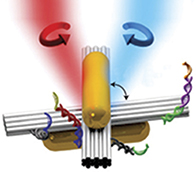Article contents
DNA nanotechnology for building artificial dynamic systems
Published online by Cambridge University Press: 12 July 2019
Abstract

A fundamental design rule that nature has developed for biological machines is the intimate correlation between motion and function. One class of biological machines is molecular motors in living cells, which directly convert chemical energy into mechanical work. They coexist in every eukaryotic cell, but differ in their types of motion, the filaments they bind to, the cargos they carry, as well as the work they perform. Such natural structures offer inspiration and blueprints for constructing DNA-assembled artificial systems, which mimic their functionality. In this article, we describe two groups of cytoskeletal motors, linear and rotary motors. We discuss how their artificial analogues can be built using DNA nanotechnology. Finally, we summarize ongoing research directions and conclude that DNA origami has a bright future ahead.
- Type
- Technical Feature
- Information
- MRS Bulletin , Volume 44 , Issue 7: The Machine Learning Revolution in Materials Research , July 2019 , pp. 576 - 581
- Copyright
- Copyright © Materials Research Society 2019
Footnotes
This article is based on The Kavli Foundation Early Career Lectureship in Materials Science presentation given by Na Liu at the 2018 MRS Fall Meeting in Boston, Mass.
References
A correction has been issued for this article:
- 4
- Cited by
Linked content
Please note a has been issued for this article.


